article_detail
Good Friday am the Procession of the Salzillos Murcia
This parade features the most important pasos of master sculptor Francisco Salzillo
A personal view of the Procession of the Salzillos in Murcia on the morning of Good Friday.
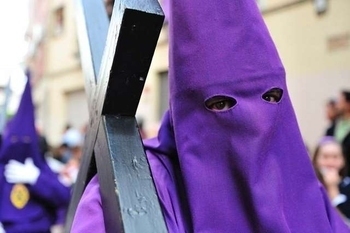 Good Friday.
Good Friday.
The most important day of the week, when the largest processions take place both in the morning and evening.
Friday morning began with the Procesión de los Salzillos, not important because of its magnitude, but 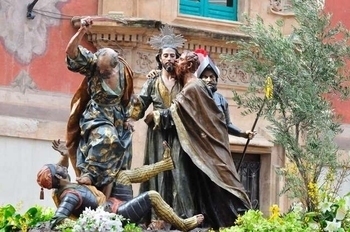 because the pasos which parade in this procession are sculpted by the most famous of Murcian sculptors, Francisco Salzillo.( Click Francisco Salzillo)
because the pasos which parade in this procession are sculpted by the most famous of Murcian sculptors, Francisco Salzillo.( Click Francisco Salzillo)
Throughout the year, these magnificent pieces reside within the Salzillo Museum in the iglesia de Jesús, along with a collection of other works by the sculptor, and are carried out into the light of day by the Muy 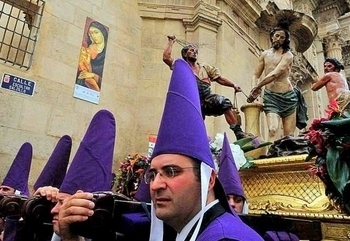 Ilustre Cofradía de Nuestro Padre Jesús on just this one day per year.
Ilustre Cofradía de Nuestro Padre Jesús on just this one day per year.
Mercifully the rain, which had shortened so many processions throughout the week, held off, and thousands turned out to watch this living work of art pass slowly through the streets.
Although 8 of the pasos which parade on this morning are by Salzillo, the ninth, a figure of Nuestro Padre Jesús Nazareno being by an unknown sculptor, many were anxious to see just one piece- La Cena, the last supper, in which Jesus sits with his disciples sharing a last meal together.
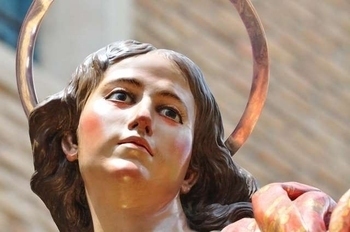 The reason this was of such interest is its recent restoration, and onlookers were amazed to see the changes wrought by the process.
The reason this was of such interest is its recent restoration, and onlookers were amazed to see the changes wrought by the process.
The piece was originally commissioned by the brotherhood in 1761 and delivered in 1763, replacing the 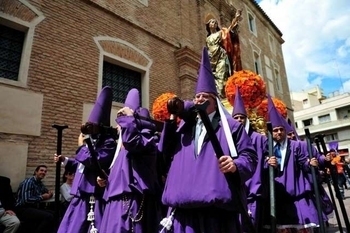 Santa Cena by the father of the sculptor, Nicolás Salzillo, which was sold to another Cofradía in Lorca and still parades in the Lorca Semana Santa. La Cena by Nicolás Salzillo was made in 1700 and is on display in the museum of the Paso Morado, and although its an impressive piece of work, lacks the fine detail and emotion of the piece made by his son.
Santa Cena by the father of the sculptor, Nicolás Salzillo, which was sold to another Cofradía in Lorca and still parades in the Lorca Semana Santa. La Cena by Nicolás Salzillo was made in 1700 and is on display in the museum of the Paso Morado, and although its an impressive piece of work, lacks the fine detail and emotion of the piece made by his son.
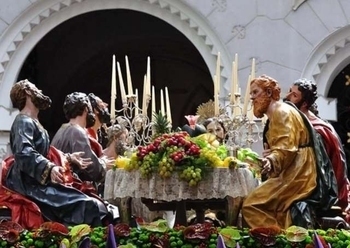 It cost 400,000 euros to restore the sculpture in the Region´s own restoration centre, and during the process several previous restorations were reversed in order to return the pieces to the condition in which they were delivered back in 1763.
It cost 400,000 euros to restore the sculpture in the Region´s own restoration centre, and during the process several previous restorations were reversed in order to return the pieces to the condition in which they were delivered back in 1763.
During the works restorers took more than 3500 photographs to document the stages and processes followed, as they carefully removed the accumulated filth of the last 300 years, along with 4 coats of paint which had been added over the years to "freshen up" the sculptures a bit as they gradually aged.
The big shock for many observers was the brightness of the colours and the paleness of the complexions of the sculptures, as the pieces which had paraded the year before had borne a heavy patina of age, a deep 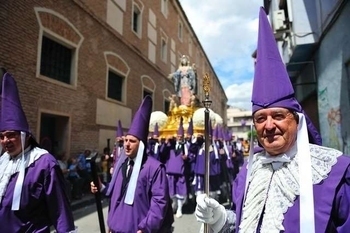 bronzed toning to the skin and clothes, but this year shone like new born lambs with a youth and freshness which totally changed the appearance of the piece.
bronzed toning to the skin and clothes, but this year shone like new born lambs with a youth and freshness which totally changed the appearance of the piece.
One of the most striking changes was the hair colour, as whilst the disciples had entered the center a universally dark haired bunch of loyal followers, they emerged sporting a wide variety of hair colours, ranging 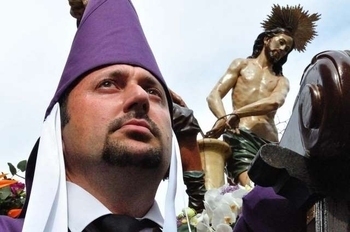 from shocking white, to shining blond, the striking red of Judas and the dark brown of Christ himself, altogether too much of a change for some who said they preferred to see old sculptures looking like old sculptures, although others had nothing but praise for the work undertaken.
from shocking white, to shining blond, the striking red of Judas and the dark brown of Christ himself, altogether too much of a change for some who said they preferred to see old sculptures looking like old sculptures, although others had nothing but praise for the work undertaken.
There´s a rare warmth of spirit in the capital, which manifested itself this day in the form of a photographer who we meet frequently whilst out and about trudging around some of the mundane press briefings which are a part of producing this information, and whom we met on a corner, a group of us all trying to get the same shot of this sculpture as it passed.
He had a trump card to play he said, and we could come with him if we wanted to, so four of us followed him 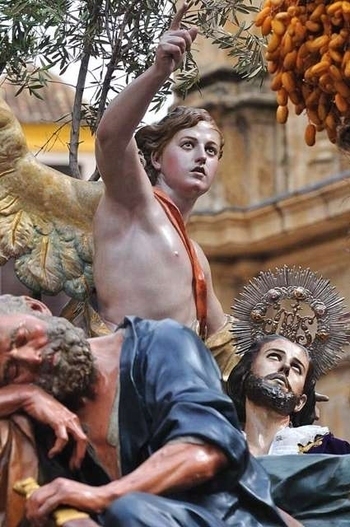 as we pushed through the crowd and out of the procession route, around a corner and in through a familiar door, the bakery we´ve often recommended to readers when preparing short routes between exhibitions, the Bonache shop in Plaza Flores, making probably the best Murcian meat pie in town, our roving reporter being an enthusiastic researcher of the famous Murcian Pastel de Carne.
as we pushed through the crowd and out of the procession route, around a corner and in through a familiar door, the bakery we´ve often recommended to readers when preparing short routes between exhibitions, the Bonache shop in Plaza Flores, making probably the best Murcian meat pie in town, our roving reporter being an enthusiastic researcher of the famous Murcian Pastel de Carne.
But his route took us through the shop and up in a lift, to the apartment looking down onto plaza Flores below, owned, it transpired, by the current generation of the family who had run the bakery for the last 150 years, and someone who we´d photographed during the previous day of homage to the Murcian meat pie without knowing this, married to the brother of the photographer, who just happened to be one of the restorers who 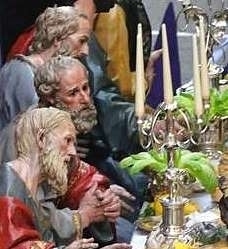 had restored La Cena, which was just about to pass below the balcony, giving us a magnificent aerial view of the sculpture from above.
had restored La Cena, which was just about to pass below the balcony, giving us a magnificent aerial view of the sculpture from above.
Now that´s what you call divine intervention.
Having spent a fascinating half hour learning all about the restoration process and more about the techniques of how the sculptures were made, it was time for a heavenly pastel de carne straight out of the oven, served with a welcome and cooling cold beer, then back out into the street to catch up with the earlier pasos which by now were reaching the Salzillo Museum after their tour of the city.
Outside the museum we met those who had just completed their gruelling penitence carrying these sculptures on their shoulders, bearing what looked like floral arrangements stuck in a cushion which was 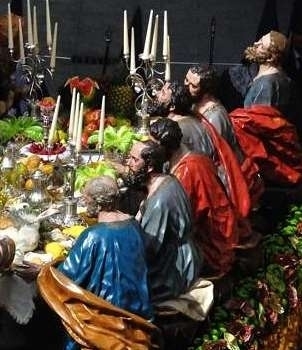 strapped to their staffs.
strapped to their staffs.
These, they explained, were the shoulder pads they had worn whilst bearing the weight of the tronos on their shoulders, now wound around the staff which was propped beneath the trono when they paused to rest, and decorated with the flowers stripped from the float they had carried. Amongst the flowers were the dates which had formed part of the palm tree we had seen passing by on one of the tronos, popular legend being that any woman who wished to conceive should eat one of the dates from this trono after the parade.
By this point, our roving reporter was wilting, so we honoured another Semana Santa tradition from a Spanish colony on the other side of the world.
Just around the corner from the Salzillo Museum is the Agustinas Convent and the Museo de la Ciudad. All of this area has a strong immigrant population, amongst them many Ecuadorian and South American residents, 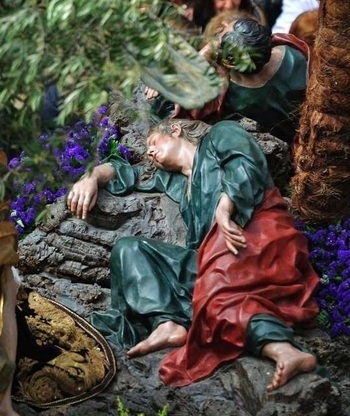 making this THE place to go if you want the best of authentic south American food. During Semana Santa a dish called fanesca is made, an enormously filling soup with 12 types of beans and grain, representing the 12 apostles, made for this one occasion a year. It´s a marvellous dish, served with a spicy chilli sauce and bread, the perfect accompaniment to the 12 apostles we had pursued through the street during the morning.
making this THE place to go if you want the best of authentic south American food. During Semana Santa a dish called fanesca is made, an enormously filling soup with 12 types of beans and grain, representing the 12 apostles, made for this one occasion a year. It´s a marvellous dish, served with a spicy chilli sauce and bread, the perfect accompaniment to the 12 apostles we had pursued through the street during the morning.
And a good area to head for if you want good value wholesome food whilst visiting the city.
So next year, this is a good procession to watch, and we´d strongly recommend choosing a spot near the Agustinas Convent to watch the tronos pass, as the atmospheric streets are narrow, giving a real feel of participation and it´s not too crowded, being close to the end of the procession.
And it also eliminates the need to crawl out of bed at 7am as the first pasos don´t reach home until mid morning.
Alternatively, visit the Salzillo Museum during the year to see the pasos in a more tranquil setting, Museo Salzillo, Murcia
The nine pasos of the Salzillo procession:
"La Santa Cena" (1763), "La Oración en el Huerto" (1754), "El Prendimiento" (1763), "Los Azotes" (1777), "La Verónica (1755), "La Caída" (1752), Nuestro Padre Jesús Nazareno (anonymous, dated around 1600) "San Juan" (1756) "La Dolorosa" (1755)
article_detail
Contact Spanish News Today: Editorial 966 260 896 /
Office 968 018 268












